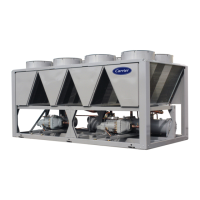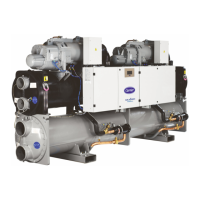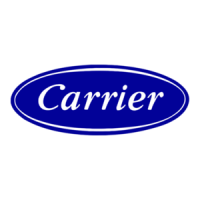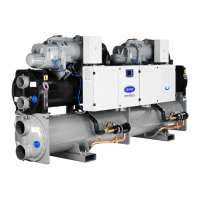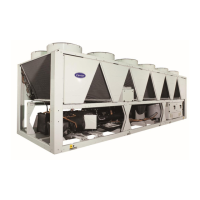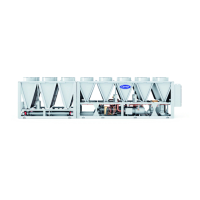CONTENTS (cont)
MAINTENANCE .................................. 66
Recommended Maintenance Schedule .......... 66
TROUBLESHOOTING ......................... 66-86
Alarms and Alerts ............................... 67
• DIAGNOSTIC ALARM CODES AND POSSIBLE
CAUSES
Service Test ..................................... 82
APPENDIX A -- LOCAL DISPLAY TABLES... 87-100
APPENDIX B -- CCN TABLES .............. 101-112
APPENDIX C -- 30XA080-500 CPM
DIP SWITCH ADDRESSES ................ 113-116
APPENDIX D -- PIPING AND
INSTRUMENTATION .......................... 117
INDEX .......................................... 118
START-UP CHECKLIST
FOR 30XA LIQUID CHILLERS ........ CL-I to CL-8
SAFETY CONSIDERATIONS
Inst_dling,starting up, and servicing this equipment can be
hazardous due to system pressures, electrical components, and
equipment location (roof. elevated structures, etc.). Only
trained, qu_dified installers and service technicians should
install, start up, and service this equipment. When working on
this equipment, observe precautions in the literature, and on
tags, stickers, and labels attached to the equipment, and any
other safety precautions that apply. Follow all safety codes.
WEar safety glasses and work gloves. Use care in handling,
rigging, and setting this equipment, and in handling _dlelectri-
c_dcomponents.
This unit uses a microprocessor-based electronic control
system. Do not use jumpel.s or other tools to short out com-
ponents, or to bypass or otherwise deDut from recom-
mended procedures. Any short-to-ground of the control
bomd or accompanying wiring may destroy the electronic
modules or electric_d components.
To prevent potential damage to heat exchanger tubes,
always run fluid through heat exchanger when adding or
removing refrigerant chm'ge. Use appropriate antifreeze
solutions in cooler fluid loop to prevent the freezing of heat
exchanger or interconnecting piping when the equipment is
exposed to temperatures below 32 F (0° C). Proof of flow
switch is factory installed on all models. Do NOT remove
power from this chiller during winter shut down periods
without taking precaution to remove all water from heat
exchangel: Failure to properly protect the system from
freezing may constitute abuse and may void wammty.
Compressors require specific rotation. Test condenser
fan(s) first to ensme proper phasing. Swap any two incom-
ing power leads to correct condenser fan rotation before
starting compressors. Operating the unit without testing the
condenser fan(s) for proper phasing could result in equip-
ment damage.
Electrical shock can cause personal inju U and death. Shut
off all power to this equipment during installation and ser-
vice. There may be morn than one disconnect switch. %g
all disconnect locations to alert others not to restore power
until work is completed.
DO NOT VENT refrigerant relief valves within a building.
Outlet from relief valves must be vented in accordance
with the latest edition of ANSI/ASHRAE (American
National Standm'ds institute/American Society of Heating,
Refrigerating and Air Conditioning Engineel.s) 15 (Safety
Code for Mechanical Refrigeration). The accumulation of
refrigerant in an enclosed space can displace oxygen and
cause asphyxiation. Provide adequate ventilation in
enclosed or low overhead meas. Inhalation of high concen-
trations of vapor is harmful and may cause heart irregulari-
ties, unconsciousness or death. Misuse can be fatal. Vapor
is heavier than air and reduces the mnount of oxygen avail-
able for breathing. Product causes eye and skin irritation.
Decomposition products am hazmdous.
DO NOT attempt to unbraze factory joints when servicing
this equipment. Compressor oil is flammable and there is
no way to detect how much oil may be in gray of the refrig-
erant lines. Cut lines with a tubing cutter as required when
performing service. Use a pan to catch any oil that may
come out of the lines and as a gage for how much oil to add
to system. DO NOT re-use compressor oil.
GENERAL
This publication contains Controls, Operation, Start-Up,
Service and Troubleshooting information for the 30XA080-
500 air-cooled liquid chillers with electronic controls. The
30XA chillers are equipped with Co;@,-tLink TM controls and
electronic expansion valves.
Conventions Used in This Manual -- The follow-
ing conventions for discussing configuration points for the
Navigator r_qmodule will be used in this manu_d.
Point names will be written with the mode name first, then
any sub-modes, then the point name, each sepm'ated by an
arrow symbol (-+). Nmnes will _dso be shown in bold
and it:dics. As an example, the Lead/Lag Circuit Select Point,
which is located in the Configuration mode, Option sub-mode,
would be written as Configuration -+OPTN-+LLCS.
This path name will show the user how to navigate through the
loc_d display to roach the desired configuration. The user would
scroll through the modes and sub-modes using the [] and []
keys. The arrow symbol in the path nmne represents pressing
to move into the next level of the menu structure.
When a value is included as pan of the path name, it will be
shown at the end of the path name after an equ_ds sign. If the
value represents a configuration setting, an explanation will
be shown in parenthesis after the value. As an exmnple,
Configuration-+OPTN-+LLCS = 1 (Circuit A leads).
Pressing the _ and _ keys simultaneously
will scroll an expanded text description of the point nmne or value
across the display. The expgmded description is shown in the local
display tables but will not be shown with the path names in text.
The CCN (Cgurier Comfort Network®) point names are
also referenced in the local display tables for users configuring
the unit with CCN software instead of the local display. The
CCN tables are located in Appendix B of the manual.
